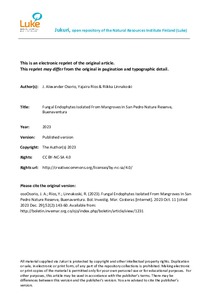Fungal Endophytes Isolated From Mangroves In San Pedro Nature Reserve, Buenaventura
Osorio, J. Alexander; Ríos, Yajaira; Linnakoski, Riikka (2023)
Osorio, J. Alexander
Ríos, Yajaira
Linnakoski, Riikka
Julkaisusarja
Boletín de Investigaciones Marinas y Costeras
Volyymi
52
Numero
2
Sivut
143-160
Marine and Coastal Research Institute INVEMAR
2023
Julkaisun pysyvä osoite on
http://urn.fi/URN:NBN:fi-fe20231229157580
http://urn.fi/URN:NBN:fi-fe20231229157580
Tiivistelmä
Mangroves offer a variety of economic, ecological, and cultural services. However, despite their importance and the diversity they harbor, anthropogenic activities have contributed to the deterioration of these habitats. Studies on endophytic fungi associated with mangrove ecosystems are still limited in Colombia. This group of fungi includes a wide variety of opportunistic pathogens often associated with trees affected by environmental and anthropogenic activities. To contribute to the knowledge of the diversity of endophytic fungi associated with mangrove trees in San Pedro Nature Reserve, Buenaventura, Colombia, branches (aprox. 10 cm length) of Laguncularia racemosa, Mora oleifera, Pelliciera rhizophorae and Rhizophora racemosa were collected for fungal isolations. The DNA was extracted and the Internal Transcribed Spacer region was amplified followed by the subsequent phylogenetic analyzes of Bayesian, maximum likelihood, and maximum parsimony. Nine genera, Bipolaris, Ciboria, Coprinellus, Cylindrobasidium, Epicoccum, Fusarium, Lasiodiplodia, Neofusicoccum and Neurospora belonging to eight families, were recognized. Of these, Fusarium, Lasiodiplodia, Neofusicoccum are well known for their high potential to threaten the health of their hosts. Results suggest that mangroves constitute an environment that has hardly been explored for the study of different groups of fungi.
Collections
- Julkaisut [87133]
